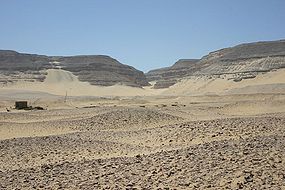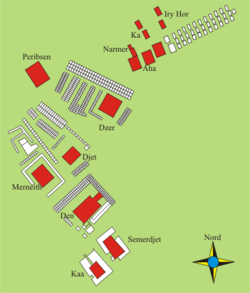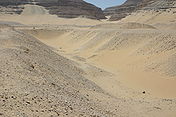
Umm el-Qa'ab
Encyclopedia

Necropolis
A necropolis is a large cemetery or burial ground, usually including structural tombs. The word comes from the Greek νεκρόπολις - nekropolis, literally meaning "city of the dead"...
of the Early Dynastic
Early Dynastic Period of Egypt
The Archaic or Early Dynastic Period of Egypt immediately follows the unification of Lower and Upper Egypt c. 3100 BC. It is generally taken to include the First and Second Dynasties, lasting from the Protodynastic Period of Egypt until about 2686 BC, or the beginning of the Old Kingdom...
kings at Abydos
Abydos, Egypt
Abydos is one of the most ancient cities of Upper Egypt, and also of the eight Upper Nome, of which it was the capital city. It is located about 11 kilometres west of the Nile at latitude 26° 10' N, near the modern Egyptian towns of el-'Araba el Madfuna and al-Balyana...
, in Egypt
Egypt
Egypt , officially the Arab Republic of Egypt, Arabic: , is a country mainly in North Africa, with the Sinai Peninsula forming a land bridge in Southwest Asia. Egypt is thus a transcontinental country, and a major power in Africa, the Mediterranean Basin, the Middle East and the Muslim world...
. Its modern name means 'Mother of Pots', as the whole area is littered with the broken pot shards of offerings made in earlier times. The cultic ancient name of the area was (w-)pkr or (r3-)pkr 'District of the poker-tree (unidentified species' or 'Opening of the poker-tree'(Coptic: upoke), belonging to t3-dsr 'the secluded/cleared land'(=necropolis)or crk-hh 'Binding of Eternity'(Coptic Alkhah.
The area was a site of veneration and worship for the Ancient Egyptians, and by the time of the Middle Kingdom
Middle Kingdom of Egypt
The Middle Kingdom of Egypt is the period in the history of ancient Egypt stretching from the establishment of the Eleventh Dynasty to the end of the Fourteenth Dynasty, between 2055 BC and 1650 BC, although some writers include the Thirteenth and Fourteenth dynasties in the Second Intermediate...
at least one of the royal tombs was excavated and rebuilt for the cult of the god Osiris
Osiris
Osiris is an Egyptian god, usually identified as the god of the afterlife, the underworld and the dead. He is classically depicted as a green-skinned man with a pharaoh's beard, partially mummy-wrapped at the legs, wearing a distinctive crown with two large ostrich feathers at either side, and...
.
The tombs of this area were first excavated by Émile Amélineau
Émile Amélineau
Émile Amélineau was a French Coptologist, archaeologist and Egyptologist. His scholarly reputation was established as an editor of previously unpublished Coptic texts...
in the 1890s and more systematically by William Matthew Flinders Petrie
William Matthew Flinders Petrie
William Matthew Flinders Petrie FRS , commonly known as Flinders Petrie, was an English Egyptologist and a pioneer of systematic methodology in archaeology and preservation of artifacts...
between 1899-1901. Since then the area has been excavated repeatedly by the German Archaeological Institute
German Archaeological Institute
The German Archaeological Institute is an institution of research within the field of archaeology , and a "scientific corporation", with parentage of the federal Foreign Office of Germany-Origin:...
since the 1970s, which has allowed for a thorough reconstruction of the original layout and appearance of these tombs.
Pre-Dynastic Tombs

- U-j – Unknown noble, but possibly Serket IScorpion IScorpion I was the first of two kings so-named of Upper Egypt during the Protodynastic Period. His name may refer to the scorpion goddess Serket....
from scorpion insignia found in tomb - B1/B2 – Iry-HorIry-HorIry-Hor or Ro was a Predynastic pharaoh of ancient Egypt, although some archaeologists are doubtful of his existence. He was most likely Ka's immediate predecessor...
- B7/B8/B9 – KaKa (Pharaoh)Ka, also Sekhem Ka or Ka-Sekhen, was a Predynastic pharaoh of Upper Egypt.- Biography :Ka ruled over Abydos in the late 32nd or early 31st century BC, and was buried at Umm el-Qa'ab. He most likely was the immediate successor to Iry-Hor and was succeeded by Narmer...
First Dynasty Tombs
Known as Cemetery B, this area contains the tombs of the kings of the First dynasty of EgyptFirst dynasty of Egypt
The first dynasty of Ancient Egypt is often combined with the Dynasty II under the group title, Early Dynastic Period of Egypt...
and the last 2 kings of the Second
Second dynasty of Egypt
The second dynasty of ancient Egypt is often combined with Dynasty I under the group title Early Dynastic Period. It dates approximately from 2890 to 2686 BC. The capital at that time was Thinis.-Rulers:...
.
- B17/B18 – NarmerNarmerNarmer was an ancient Egyptian pharaoh of the Early Dynastic Period . He is thought to be the successor to the Protodynastic pharaohs Scorpion and/or Ka, and he is considered by some to be the unifier of Egypt and founder of the First Dynasty, and therefore the first pharaoh of unified Egypt.The...
- B10/B15/B19 – AhaHor-AhaHor-Aha is considered the second pharaoh of the first dynasty of ancient Egypt in current Egyptology. He lived around the thirty-first century BC.- Name :...
- O – DjerDjerDjer was the second or third pharaoh of the first dynasty of Egypt, which dates from approximately 3100 BC. Some scholars, however, debate whether the first pharaoh, Menes or Narmer, and Hor-Aha might have been different rulers. If they were separate rulers, this would make Djer the third pharaoh...
- Z – DjetDjetDjet, also known as Wadj, Zet, and Uadji , was the fourth Egyptian pharaoh of the first dynasty...
- Y – MerneithMerneithMerneith was a consort and a regent of Ancient Egypt during the first dynasty. She may have been a ruler of Egypt in her own right. The possibility is based on several official records. Her rule occurred the thirtieth century B.C., for an undetermined period of time...
- T – DenDen (Pharaoh)Den, also known as Hor-Den, Dewen and Udimu, is the Horus name of an early Egyptian king who ruled during the 1st dynasty. He is the best archaeologically attested ruler of this period. Den is said to have brought prosperity to his realm and numerous innovations are attributed to his reign...
- X – AnedjibAnedjibAnedjib, more correctly Adjib and also known as Hor-Anedjib, Hor-Adjib and Enezib, is the Horus name of an early Egyptian king who ruled during the 1st dynasty. The ancient Greek historian Manetho named him "Miebîdós" and credited him with a reign of 26 years, whilst the Royal Canon of Turin...
- U – SemerkhetSemerkhetSemerkhet is the Horus name of an early Egyptian king who ruled during the 1st dynasty. This ruler became known through a tragic legend handed down by ancient Greek historian Manetho, who reported that a calamity of some sort occurred during Semerkhet's reign...
- Q – Qa'aQa'a-Legacy:Qa'a had a fairly large tomb in Abydos which measures 98.5 X 75.5 feet or 30 X 23 meters. Manetho gives him a reign of 26 years in his Epitome if this ruler was a certain Biechenes. A long reign is supported by the large size of this ruler's burial site at Abydos...
Second Dynasty Tombs
The last two kings of the Second DynastySecond dynasty of Egypt
The second dynasty of ancient Egypt is often combined with Dynasty I under the group title Early Dynastic Period. It dates approximately from 2890 to 2686 BC. The capital at that time was Thinis.-Rulers:...
returned to be buried near to their ancestors - they also revived the practice of building mud-brick funerary enclosures nearby.
- P – PeribsenSeth-PeribsenPeribsen is the serekh name of an early Egyptian king who ruled during the 2nd dynasty. Unlike many other pharaohs of this dynasty, Peribsen is well-attested in the archaeological records...
A seal found in this tomb contains the first full sentence written in hieroglyphs
Egyptian hieroglyphs
Egyptian hieroglyphs were a formal writing system used by the ancient Egyptians that combined logographic and alphabetic elements. Egyptians used cursive hieroglyphs for religious literature on papyrus and wood...
.
- V – KhasekhemwyKhasekhemwyKhasekhemwy was the fifth and final king of the Second dynasty of Egypt. Little is known of Khasekhemwy, other than that he led several significant military campaigns and built several monuments, still extant, mentioning war against the Northerners...

SARD
is a Japanese tuning company and racing team from Toyota, Aichi, mainly competing in the Super GT series and specialising in Toyota tuning parts.-History:...
and banded with gold, limestone vases with golden covers, and a ewer and basin of bronze.
Human sacrifice and 1st Dynasty tombs
Human sacrificeHuman sacrifice
Human sacrifice is the act of killing one or more human beings as part of a religious ritual . Its typology closely parallels the various practices of ritual slaughter of animals and of religious sacrifice in general. Human sacrifice has been practised in various cultures throughout history...
was practiced as part of the funerary rituals associated with the first dynasty. The tomb of Djer is associated with the burials of 338 individuals thought to have been sacrificed. The people and animals sacrificed, such as asses, were expected to assist the pharaoh in the afterlife. It appears that Djer's courtiers were strangled and their tombs all closed at the same time. For unknown reasons, this practice ended with the conclusion of the dynasty, with shabtis taking the place of actual people to aid the pharaohs with the work expected of them in the afterlife.

